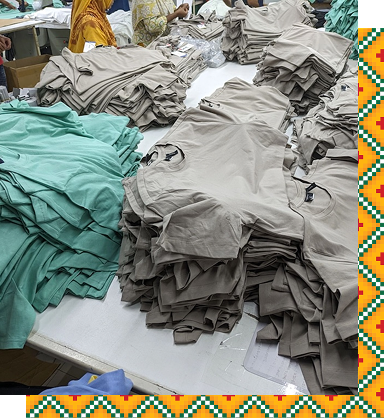Textiles and Garments Sector
Despite challenges such as limited skilled workforce, production scale, efficiency, and fabric supply, the T&G industry in Ghana has shown significant growth potential, producing high-quality products for niche markets, especially the U.S.A.
Strategic Importance
Local and Global Context
The industry is among the largest employers globally and a major contributor to GDP and the Sustainable Development Goals (SDGs).

Global Trends in the Textiles and Garments Sector

Demand Growth

Shifts in Sourcing Patterns
Global trade in textiles and clothing, valued at $958 billion in 2022, has shifted from China to emerging regions like Africa and Central America due to rising costs and geopolitical factors. Africa’s share of global trade is currently negligible (about 1%) but expected to increase due to its abundant labour supply, competitive wages, and preferential market access. However, growing geopolitical tensions and increasingly strict ESG standards make familiar trends more complex.

Intensification of near-shoring
EU and U.S. markets increasingly prefer the reliability of proximate suppliers, notably to support the fast-fashion industry. Near-shore location share of garment procurement increased from 39% in 2015 to 50% by 2021.

Polyester dominates
Cost-effective polyester will dominate future markets, but regenerative cotton has a resilient market share. Polyester will be 59% of the textiles market by 2030; cotton’s share will reduce, but aggregate size will hold.

Sustainability

Digitalisation

New Business Models
Ghana’s T&G Industry Segments
Textile Mills
Garment Manufacturing
Regional Trends
Ghana has tariff-free access to three key export markets—the EU, US, and ECOWAS—with a total value of $298B, dwarfing its national market of ~ $2B.
Ghana also benefits from initiatives like the ‘Partenariat pour le Coton’, launched by the World Trade Organisation and partners to develop the T&G industry in West Africa. The International Finance Corporation (IFC) approved $8 million in funding for a large garment manufacturing facility in Greater Accra in 2022, supporting Ghana’s ambition to become a regional T&G hub. DTRT Apparel Group, the largest garment manufacturer in West Africa, employs over 5,000 workers and aims to create an additional 6,000 jobs.
Opportunities for Investmnent
Industrial Textile Parks
Modernising Textile Mills
Sustainable Industries
Accessory Manufacturing
Establish factories for basic, decorative, and finishing garment accessories like zippers, buttons, and labels.
Textile Recycling
Government Measures

Preferential Trade Agreements
Duty-free exports under agreements like AGOA (U.S.), EPA (EU), and ECOWAS protocols.

Investment Incentives

